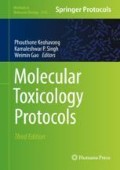Abstract
RNA sequencing (RNA-seq) is a recently developed approach to perform transcriptome profiling using next-generation sequencing (NGS) technologies. Studies have shown that RNA-seq provides accurate measurement of transcript levels as well as their isoforms, which is useful to address complex transcriptomes. In addition, the increasing publicly available sequencing datasets and decreasing sequencing cost promote the use of RNA-seq for hypothesis-generating studies. In this chapter, we demonstrate how to analyze RNA-seq data and generate interpretable results using CLC genomic workbench software and perform the downstream pathway analysis using ingenuity pathway analysis (IPA).
Access this chapter
Tax calculation will be finalised at checkout
Purchases are for personal use only
References
Wang Z, Gerstein M, Snyder M (2009) RNA-seq: a revolutionary tool for transcriptomics. Nat Rev Genet 10(1):57–63. https://doi.org/10.1038/nrg2484
van Hal NL, Vorst O, van Houwelingen AM, Kok EJ, Peijnenburg A, Aharoni A, van Tunen AJ, Keijer J (2000) The application of DNA microarrays in gene expression analysis. J Biotechnol 78(3):271–280
Okoniewski MJ, Miller CJ (2006) Hybridization interactions between probesets in short oligo microarrays lead to spurious correlations. BMC Bioinformatics 7:276. https://doi.org/10.1186/1471-2105-7-276
Royce TE, Rozowsky JS, Gerstein MB (2007) Toward a universal microarray: prediction of gene expression through nearest-neighbor probe sequence identification. Nucleic Acids Res 35(15):e99. https://doi.org/10.1093/nar/gkm549
Ozsolak F, Milos PM (2011) RNA sequencing: advances, challenges and opportunities. Nat Rev Genet 12(2):87–98. https://doi.org/10.1038/nrg2934
Byron SA, Van Keuren-Jensen KR, Engelthaler DM, Carpten JD, Craig DW (2016) Translating RNA sequencing into clinical diagnostics: opportunities and challenges. Nat Rev Genet 17(5):257–271. https://doi.org/10.1038/nrg.2016.10
Mortazavi A, Williams BA, McCue K, Schaeffer L, Wold B (2008) Mapping and quantifying mammalian transcriptomes by RNA-seq. Nat Methods 5(7):621–628. https://doi.org/10.1038/nmeth.1226
Koch CM, Chiu SF, Akbarpour M, Bharat A, Ridge KM, Bartom ET, Winter DR (2018) A Beginner’s guide to analysis of RNA sequencing data. Am J Respir Cell Mol Biol 59(2):145–157. https://doi.org/10.1165/rcmb.2017-0430TR
https://www.qiagenbioinformatics.com/blog/discovery/lasting-expressions/
https://www.qiagenbioinformatics.com/products/clc-genomics-workbench
https://www.qiagenbioinformatics.com/products/ingenuity-pathway-analysis/insightful/
http://qiagen.force.com/KnowledgeBase/KnowledgeIPAPage?id=kA1D0000000PIpcKAG
Ewing B, Green P (1998) Base-calling of automated sequencer traces using phred. II. Error probabilities. Genome Res 8(3):186–194
Acknowledgments
CLC Genomics Workbench and IPA software licensed through the Molecular Biology Information Service of the Health Sciences Library System, University of Pittsburgh, were used for data analysis.
Author information
Authors and Affiliations
Corresponding author
Editor information
Editors and Affiliations
Rights and permissions
Copyright information
© 2020 Springer Science+Business Media, LLC, part of Springer Nature
About this protocol
Cite this protocol
Liu, CH., Di, Y.P. (2020). Analysis of RNA Sequencing Data Using CLC Genomics Workbench. In: Keohavong, P., Singh, K., Gao, W. (eds) Molecular Toxicology Protocols. Methods in Molecular Biology, vol 2102. Humana, New York, NY. https://doi.org/10.1007/978-1-0716-0223-2_4
Download citation
DOI: https://doi.org/10.1007/978-1-0716-0223-2_4
Published:
Publisher Name: Humana, New York, NY
Print ISBN: 978-1-0716-0222-5
Online ISBN: 978-1-0716-0223-2
eBook Packages: Springer Protocols

